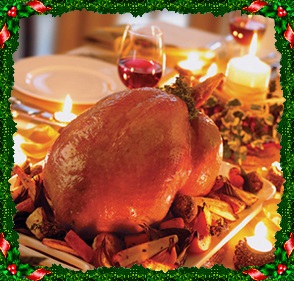Our Lazy Man’s Step-by-Step Guide
Discover how to roast the perfect Christmas Turkey
and cook the perfect Turkey Roll
How To Roast a Turkey: The Simplest, Easiest Method
(**** If planning to stuff your turkey, an ideal time to do this would be between steps 2 and 3****)

Ingredients
- 1 turkey (any size),
- 1 cup unsalted butter,
- 1 tablespoon salt and,
- 1 teaspoon of black pepper,
- vegetables if desired.
Equipment
- Roasting pan (or an alternative roasting dish),
- Roasting rack (or something to lift the turkey off the pan),
- Turkey baster, brush, or ladle (optional, if basting).
Instructions
1. Prepare the turkey for roasting: thirty minutes to an hour before roasting, take the turkey out of the fridge. Remove the vacuum sealed packaging and clear the cavity of neck and giblets ( if appropriate).
2. Using a paper towel, pat the turkey dry of juices. ( *** If planning to stuff your turkey, an ideal time to do this would be now ***)
3. Set the turkey breast-side up on the roasting rack and let it sit while the oven preheats. This takes the chill off the meat, which helps the meat cook faster and more evenly. It also gives the skin time to dry out, which promotes browning and crisping. (Note: Your turkey will likely still feel cool to the touch after sitting at room temperature — that’s fine and you can continue on with roasting.)
4. Preheat the oven to 200 C: position an oven rack in the bottom third of your oven and preheat the oven to 200 C. If you brined your turkey, no need to do anything now. If your turkey is straight out of the package, rub the whole skin with the butter and season to your liking or with the salt and pepper before putting it in the oven. We recommend leaving your turkey un-stuffed and un-trussed, both because it’s easier and because the turkey will cook more evenly.
5. You can add your vegetables into the roasting pan if desired. When ready to roast, you can place your vegetables in the bottom of the roasting pan. If you don’t want vegetables, you can simply add a cup of water to the bottom of the roasting pan.
6. Place the turkey in the oven and turn down the heat: place the turkey in the oven and turn down the heat to 180 C. We recommend roasting your turkey breast-side up. Some people like starting the turkey breast-side down to shield the breast meat, but the idea of flipping a hot, sputtering turkey is not our idea of a good time. Instead, we prefer to simply shield the breast meat by loosely covering it with foil toward the end of cooking if it starts getting too browned.
7. Roast the turkey: the rule of thumb for cooking a turkey is 45 – 50 minutes per kilo. So a 5 kilo turkey was estimated to cook in about 3 hours & 45 minutes to 4 hours 10 minutes. However, some factors like brining the bird, cooking with an empty (un-stuffed) cavity, and leaving the legs un-trussed will contribute to much faster cooking. Plan on the 45 – 50 minutes per kilo rule, but start checking the temperature of your turkey about halfway through the scheduled cooking time to gauge how fast it’s cooking.
8. Baste the turkey every 45 minutes: every 45 minutes, remove the turkey from the oven, close the oven door (don’t let that heat out!), and baste the turkey all over. To baste, tilt the pan and use a turkey baster or spoon to scoop up the pan liquids and drizzle them on top of the turkey. Basting with pan juices cools the surface of the turkey and slows down cooking, which in turn keeps the breast meat cooking at close to the same rate as the legs and thighs. If you have added water to the roasting pan, you can baste your turkey with some melted unsalted butter. In the last 45 minutes or so of cooking, you can also baste the turkey with melted butter or oil. This helps crisp up the skin and turn it a beautiful deep golden brown.
9. Check the turkey’s temperature: begin checking the turkey’s temperature about halfway through the estimated cooking time. Check the temperature in three places: the breast, outer thigh, and inside thigh. In every case, the meat should be at least 75 c when the turkey has finished cooking. Because the breast meat is the thickest part of the turkey, it should be the last place to reach the 75 c temperature. The thighs and drumsticks will be a higher temperature by this stage but that’s ok. If any place is under that temperature, put the turkey back in the oven for another 20 minutes. Shield the breast meat by loosely covering with foil if needed to keep it from overcooking.
10. Rest the turkey before carving: grab one side of the roasting rack with an oven mitt and tilt the whole pan so the liquids inside the turkey cavity run out into the pan. (These juices are used to make the gravy.) Then, lift the whole turkey (still on the rack) and transfer it to a cutting board. Tent the turkey with aluminium foil and let it rest for at least 20 minutes. This gives time for the meat to firm up and the juices to be re-absorbed into the muscle tissue, making the turkey easier to slice and taste juicier.
11. Carve the turkey: carve the turkey the same way you would carve a chicken. Remove the wings first, then the thighs, then the breast meat. Once you have the meat off, you can separate the thighs into thighs and drumsticks and carve the breast meat into individual slices.
12. Don’t forget about the leftovers: one final note! Once you’ve sat down at the table, don’t forget about the turkey back on the counter. The leftover meat needs to be refrigerated within two hours of cooking, after which the risk of something nasty taking up residence starts to increase exponentially. Be safe!
Ways to Add Flavour to Your Turkey
Rub your turkey with butter or oil for a richer flavour and browner skin, rub minced herbs or ground spices into (or beneath) the skin for more flavour, place a few halved lemons, halved onions or garlic cloves inside the cavity of the turkey.
How To Cook a Turkey Roll: The Simplest, Easiest Method
Instructions

1. Prepare the turkey roll for roasting: thirty minutes to an hour before roasting, take the turkey roll out of the fridge. Remove the plastic packaging but leave the netting as is.
2. Using a paper towel, pat the turkey roll dry of juices.
3. Transfer the turkey roll to a baking tray and season to your liking. A simple mix of salt, black pepper and olive oil would also do the trick.
4. Preheat the oven to 180C.
5. Cover the roll loosely with foil and place into your oven.
6. A turkey fillet roll needs to cook for an 1hr for the first kilo then 40mins per kilo thereafter. For example a 2kg turkey roll will take approximately 1hr and 40mins to cook.
7. Remove the foil completely from your turkey roll for the final 30 mins to brown it.
8. If unsure, your turkey roll is cooked when juices run clear after being pierced in the thickest part of the roll with a skewer.
9. Allow your turkey roll to rest in a warm place for approximately 15minutes before carving. This will ensure that the juices have settled and will make the meat very succulent.
10. While your turkey roll is resting, strain the juices from the baking tray. You can use these to make a delicious gravy.
11. Remove the netting and slice approx 1 – 1.5 centimetres thick to serve.
Cooking Instructions as PDF Files
The cooking instructions above are in a PDF file below. Click once on the links below to view or to download the instructions.
